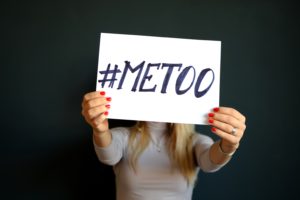SEXUAL HARASSMENT: WHAT HAVE WE LEARNED AND WHERE DO WE GO FROM HERE?
I want to provide an example in my own experience relating to sexual harassment. I was recently at an event where I had an interaction with three other colleagues. Let’s call them Mike, Judy, and Ann. I was sitting with Judy and Ann when Mike approached and gave Judy a long and awkward hug. He seemed to be very close to her and extremely comfortable. He sat down and chatted for a few minutes, appearing somewhat intoxicated. When he exited, Judy stated, “That was embarrassing.” She explained that she did not know Mike well and that his physical touching was not welcome or appreciated. You could see she was visibly upset about it. Ann, who knew Mike better, stated, “That’s just Mike.”
This is sexual harassment 101. Mike likely walked away from the encounter not thinking he did anything inappropriate, and quite frankly not even recalling the interaction. Ann dismissed Judy’s reaction as Mike being Mike. And even I, who does this for a living, failed to say anything. In the end, Judy felt badly about herself, the interaction and her stature at the event. In any setting, this is wrong, but in an employment setting it is lethal.
A couple of months ago, we prepared a blog regarding sexual harassment after the Fox News sexual harassment complaints and terminations became public. Since then, the world has been turned on its ear with new and shocking revelations involving politicians, media members, entertainers and other high-profile members of our society. It is clear that we are at a critical fork in the road relating to the treatment of all people, but specifically women, in the workplace and in general society.
Some of these acts involve significant acts of harassment, intimidation and sexual assault. Any person with general common sense would acknowledge that these acts are wrong, illegal and grossly inappropriate. Any employer, fellow employee or third-party that witnesses these types of egregious actions should report them and make efforts to protect their co-workers, friends and colleagues. Quite frankly, you do not need an employment lawyer to advise you that these acts are wrong, the wrongdoer needs to be terminated, and the employee needs to be protected.
Instead, we want to focus on the more subtle, ambiguous and less understood forms of sexual harassment. Many employers, and people in general, simply do not understand what constitutes sexual harassment. As a result, they do not handle interactions and claims appropriately, which leads to significant risk for the everyday employer. The most important thing for anyone to appreciate about sexual harassment is that what you may deem “acceptable,” “appropriate,” “fun” or “good natured” simply may not be acceptable or appropriate to others and may constitute sexual harassment. When Charlie Rose stated, “I am a hugger,” as a defense, he thought his touching of women was wholly acceptable, when in reality it was far from it.
Comments about someone’s looks or attire, a kiss, hug or other physical interaction, or an email with sexual content, may be fun or good natured to you, but may make others feel uncomfortable, embarrassed or awkward. The employer’s inability to appreciate the feelings of these workers, and stop this form of harassment can create tremendous issues and legal liability.
 Most people have encountered similar experiences, in a workplace or otherwise. But the question is, how do we prevent it in the future, and how do we better handle it when it does occur?
Most people have encountered similar experiences, in a workplace or otherwise. But the question is, how do we prevent it in the future, and how do we better handle it when it does occur?
First, every employer, big or small, needs to appreciate where we are as a society and the risk they face doing nothing. Every employer needs to invest in real sexual harassment training. Everyone, employers, supervisors and workers need to understand what sexual harassment is, and how to prevent it. With better education comes knowledge and understanding, and hopefully less of these inappropriate encounters.
Second, every company must have a real sexual harassment policy. Employees must be comfortable reporting acts of misconduct and there must be an appropriate and legitimate process to investigate claims and take corrective action. Most issues can be resolved if the employee has a process to have these claims investigated and resolved. Problems arise when the employer fails to recognize the claim and take appropriate action to resolve the problem.
Third, along with training, the employer must better recognize sexual harassment and be proactive in addressing it. If the employer or supervisor witnesses an awkward encounter, receives a questionable email or hears rumors about inappropriate conduct, he/she must not ignore it. Investigate it, document your findings and reprimand the employees accordingly. Never ignore a claim, dismiss it or interject your personal views in place of the party making the complaint. The employer has to act as the shield for its employee against bad acts. If the employee does not feel protected by his/her employer, litigation generally will commence.
Overall, employers must understand that the world is truly changing. A bury your head in the sand approach simply is not going to work anymore. Employers need to provide better education and understanding to protect their employees and avoid legal liabilities. There are clear ways to move forward; employers just have to be willing to do so.
If you are concerned about potential sexual harassment claims or you are facing a complaint, contact us for a consultation.
Interested in learning more about how to prevent and respond to sexual harassment claims? Listen to Jeff Ettenger’s interview on the Law You Should Know radio show.
